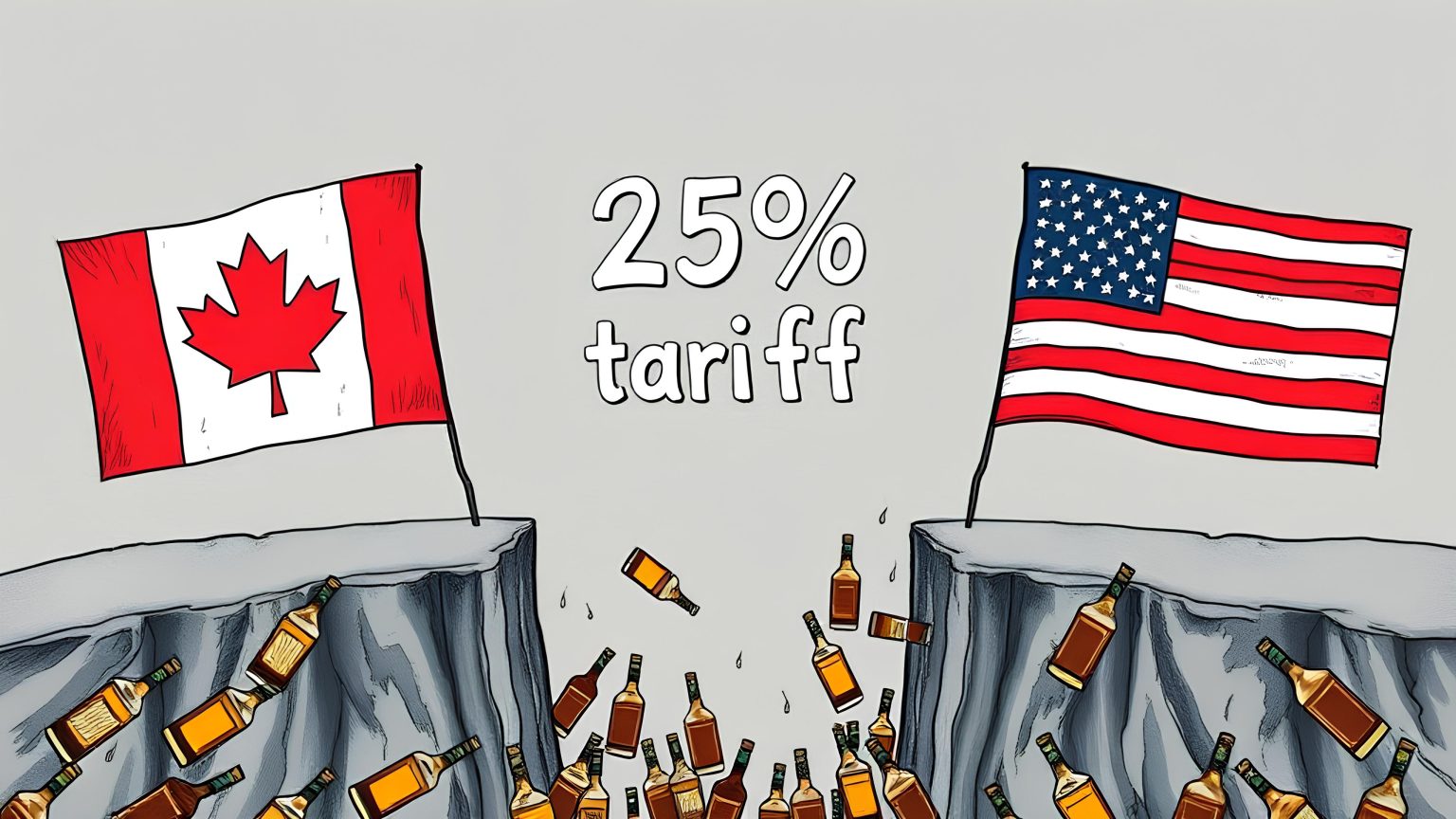On March 4, 2025, Canada slapped a 25% tariff on $30 billion worth of American goods, and the spirits and beverage industry landed right in the line of fire. Coffee, beer, wine, vodka, whiskey, rum—the staples of any good bar—are now pricier north of the border. But Canada didn’t stop there. Provinces like Ontario, Quebec, and British Columbia have pulled U.S. spirits from shelves, swapping them for local labels in a defiant pushback. Sparked by recent U.S. tariff measures on Canadian and Mexican goods, this escalating trade dispute is disrupting a long-standing cross-border spirits market. As the fallout unfolds, the industry braces for what’s next.
Canada’s Double Blow: Tariffs and Shelf Bans
Canada’s retaliation came fast and hit hard. As of 12:01 a.m. on March 4, a 25% tariff kicked in on $30 billion in U.S. goods, with Prime Minister Justin Trudeau vowing to scale it up to $155 billion in 21 days unless the U.S. relents. The first wave targets a laundry list of drinks: coffee, tea, malt beer, wine, and spirits like vodka, whiskey, and rum. Then came the provincial one-two punch.
Ontario’s Liquor Control Board (LCBO) stopped buying U.S. alcohol, clearing 3,600 products from 35 states off its shelves, websites, and apps. Quebec’s SAQ mirrored the move, halting imports of American wines, spirits, and beers while scrubbing them from stores and promotions. British Columbia piled on, pledging to ditch liquor from “red states.” These measures are locked in until the U.S. backs off, and they’ve got the industry reeling.
“It’s extremely disheartening,” said Chris Swonger, President and CEO of the Distilled Spirits Council of the U.S. (DISCUS), on March 4. “This misguided retaliation will needlessly reduce revenues for provinces and hurt Canadian consumers, tourists, and hospitality businesses.” After decades of tariff-free trade, the sudden rupture stings.
American Spirits Take a Hit
For U.S. spirits producers, the damage is immediate. Canada is the second-largest export market for American spirits, raking in $221 million in 2024. That 25% tariff could price brands out of reach, especially as Canadian alternatives swoop in. DISCUS warns that the pain cuts deeper—U.S. companies with Canadian whisky or Mexican tequila in their portfolios face a squeeze from both sides, with American tariffs hitting their imports too. An economic analysis from DISCUS pegs the potential job losses at over 31,000 if this keeps up.
The ripple effects are already lapping at consumers and businesses. The Toasts Not Tariffs Coalition, in a March 5 statement, cautioned that these tariffs “will result in great harm to U.S. companies and employees throughout the wine and spirits supply chain,” from shippers to bartenders still clawing back from pandemic losses. Higher prices loom for Canadian drinkers too, as Trudeau warned that U.S. tariffs will jack up costs for Americans—and the same logic applies north of the border.
Canada’s Opportunity—and Its Risks
Canada’s domestic spirits scene could seize the moment. Quebec’s SAQ is touting local wines and spirits to fill the void, while Ontario and British Columbia push brands like Crown Royal and Wayne Gretzky Estates to rally consumers around homegrown whisky, beer, and wine. It’s a chance for craft distillers and brewers to shine, riding a wave of national pride.
But it’s not all smooth sipping. Rewiring supply chains on the fly could hike costs for retailers and bars, and consumers might chafe at pricier drinks or the loss of beloved U.S. labels. A joint statement from DISCUS, the Chamber of the Tequila Industry, and Spirits Canada underscores the stakes: “The North American spirits sector is highly interconnected. Many companies own brands in all three countries, contributing positively to local economies.” They warn that disrupting this balance risks a “cycle of retaliatory tariffs” that could tank an industry already slowed by post-COVID woes and inflation.
What’s Next: Escalation or Negotiation?
The future’s hazy—and that’s putting it mildly. Canada’s hinted at more non-tariff moves, with Trudeau’s team in “active discussions” with provinces. Ontario’s Doug Ford has even floated cutting energy exports to the U.S. Northeast. If the ban on U.S. alcohol widens, American spirits could disappear from Canadian shelves entirely, disrupting a market worth $221 million annually.
Across the border, Trump’s holding firm, pegging April 2 as the “reciprocal tariff date” for major trading partners. That could mean steeper rates or wider targets, potentially ensnaring American whiskey in fresh retaliation. DISCUS fears the worst, noting that U.S. spirits imports from Canada ($622 million in 2024) and Mexico ($5.2 billion in tequila alone) are vulnerable. Add in the EU’s looming threat of a 50% tariff on U.S. whiskey by late March, and the industry’s staring down a perfect storm.
Still, there’s a lifeline. The DISCUS-Chamber-Spirits Canada trio is pushing for dialogue, arguing that spirits like bourbon, tequila, and Canadian whisky—tied to their homelands by law—shouldn’t be trade war fodder. “Since the 1990s, trade in spirits in North America has been largely tariff-free,” they note, pointing to a 147% jump in U.S.-Canada spirits trade and a 4,080% surge with Mexico. The Toasts Not Tariffs Coalition echoed that plea on March 5, urging Trump to spare Mexican and Canadian alcohol. Success hinges on untangling trade from thornier issues like border security—a tall order.
The Bottom Line: A Storm Brewing
This isn’t just a political slugfest—it’s a reckoning for North America’s spirits trade. American exporters are losing ground, Canadian producers are scrambling to capitalize, and consumers are stuck in the crossfire. The joint statement puts it bluntly: “Maintaining fair and reciprocal duty-free access for all distilled spirits is crucial for supporting jobs and shared growth.” For businesses, it’s time to batten down the hatches—rethink supply chains, eye new markets, and watch Washington and Ottawa like hawks.
What’s in your glass tomorrow? With billions in trade and thousands of livelihoods hanging in the balance, the answer’s still up in the air. Stick with us as we track the storm’s next move.

